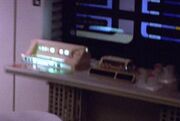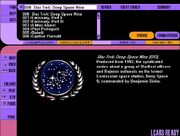m (moved LCARS to Library Computer Access and Retrieval System: Proper name) |
Deevolution (talk | contribs) (cleaned up image situation) Tag: sourceedit |
||
| (37 intermediate revisions by 23 users not shown) | |||
| Line 1: | Line 1: | ||
| + | {{at|xx}} |
||
| − | __NOTOC__[[File:Sisko outlines operation return.jpg|thumb|The battle plan of [[Operation Return]] from [[2374]] as depicted on an LCARS terminal]] |
||
| − | [[File: |
+ | __NOTOC__[[File:Sensor activity 063268.jpg|thumb|The crew of the ''Enterprise''-E view LCARS display terminals on the bridge in [[2379]]]] |
| − | [[File:Son'a research display.jpg|thumb|[[Commander]] [[William T. Riker]] accesses an LCARS terminal in [[2375]]]] |
||
| − | [[File:Sensor activity 063268.jpg|thumb|The crew of the {{USS|Enterprise|NCC-1701-E|-E}} views an LCARS terminal on the bridge in [[2379]]]] |
||
| ⚫ | |||
| − | The '''Library Computer Access''' and '''Retrieval System''' ('''LCARS''' or simply '''library computer''' for short) was the name of the [[computer]] operating system employed by the [[United Federation of Planets]], used aboard [[Starfleet]] vessels, starbases and space stations. It was accessible by both [[control interface|voice and keypad commands]]. |
+ | The '''Library Computer Access''' and '''Retrieval System''' ('''LCARS''' or simply '''library computer''' for short) was the name of the [[computer]] operating system employed by the [[United Federation of Planets]], used aboard [[Starfleet]] vessels, starbases, and space stations. It was accessible by both [[control interface|voice and keypad commands]]. |
| − | LCARS used sophisticated [[artificial intelligence]] routines to understand and execute vocal natural language commands. Starfleet personnel also frequently interfaced with LCARS with [[PADD]]s, [[tricorder]]s and control panels. |
+ | LCARS used sophisticated [[artificial intelligence]] routines to understand and execute vocal natural language commands. Starfleet personnel also frequently interfaced with LCARS with [[PADD]]s, [[tricorder]]s, and control panels. |
| + | |||
| + | [[File:Long range scan 081588.jpg|thumb|LCARS controls aboard the ''Enterprise''-E in [[2379]]]] |
||
In the [[24th century]], graphical controls housed underneath touch-sensitive clear panels allowed LCARS panels to be quickly reconfigured by users to suit the task at hand, including a [[tactile interface]] for visually-impaired officers. ({{VOY|Year of Hell}}) This enabled even complicated tasks to be executed with just a few button presses. LCARS also controlled the retrieval and storage of files in the data banks housed within the ship's [[computer core]]s. |
In the [[24th century]], graphical controls housed underneath touch-sensitive clear panels allowed LCARS panels to be quickly reconfigured by users to suit the task at hand, including a [[tactile interface]] for visually-impaired officers. ({{VOY|Year of Hell}}) This enabled even complicated tasks to be executed with just a few button presses. LCARS also controlled the retrieval and storage of files in the data banks housed within the ship's [[computer core]]s. |
||
| Line 13: | Line 12: | ||
Depending on the starship, the LCARS design, especially the color scheme, differed. These colors could range from a yellow/white (found on the {{USS|Enterprise|NCC-1701-D|-D}}) to blue/white scheme (found on the {{USS|Enterprise|NCC-1701-E|-E}}). |
Depending on the starship, the LCARS design, especially the color scheme, differed. These colors could range from a yellow/white (found on the {{USS|Enterprise|NCC-1701-D|-D}}) to blue/white scheme (found on the {{USS|Enterprise|NCC-1701-E|-E}}). |
||
| + | LCARS were subsystems in the main computer system. ({{TNG|The Vengeance Factor}}) |
||
| ⚫ | |||
| ⚫ | |||
| ⚫ | |||
| + | |||
| ⚫ | |||
| + | |||
| + | ''In the [[alternate reality]], in the [[2250s]], PCAP was the equivalent of LCARS.'' ({{film|11}}; {{film|12}}) |
||
== Library computer information == |
== Library computer information == |
||
| Line 29: | Line 32: | ||
* [[D.C. Fontana]] |
* [[D.C. Fontana]] |
||
| − | === Background === |
+ | === Background information === |
| + | A close-up view of one of the science stations aboard the ''Enterprise''-D in "The Vengeance Factor" has the label "Library Computer Subsystems". {{eas|observations/thevengeancefactor/36-thevengeancefactor-1-r.jpg}} |
||
| ⚫ | |||
| + | |||
| ⚫ | |||
| + | |||
| ⚫ | According to a ''Next Generation'' episode [[text commentary]] by [[Michael Okuda|Michael]] and [[Denise Okuda]], the LCARS displays were rarely actual computer simulations; one such example was the computer screen used by Romulan Commander [[Sela]] to monitor the Federation fleet during her attempt to smuggle weapons and supplies to [[Lursa]] and [[B'Etor]] during the Klingon civil war in the episode {{e|Redemption II}}. This was due, according to the Okudas, to both the high cost and primitive state of computer graphics in the late 1980s and early 1990s. Therefore, most LCARS displays were, in fact, plastic panels with spinning light devices behind them to give the impression that the information on the "displays" was changing. |
||
| + | |||
| ⚫ | |||
| ⚫ | |||
| ⚫ | |||
| ⚫ | |||
| ⚫ | |||
| ⚫ | In the first two seasons of ''The Next Generation'', large black rectangles are clearly visible on the LCARS displays on the bridge (and sometimes in main engineering). This was a result of the studio lights reflecting off the displays, which director of photography [[Edward R. Brown]] tried to solve by sticking cardboard onto them. When Brown was replaced by [[Marvin V. Rush]] for the third season, a number of changes in filming (including better film stock and a smaller number of lights) allowed the LCARS displays to be seen properly. {{eas|inconsistencies/curiosities.htm}} |
||
| ⚫ | |||
| ⚫ | |||
[[File:Deep Space Nine CD Companion.jpg |thumb|LCARS as seen in the ''DS9 CD Companion'']] |
[[File:Deep Space Nine CD Companion.jpg |thumb|LCARS as seen in the ''DS9 CD Companion'']] |
||
| − | + | The LCARS layout has been used in several computer games and applications such as the CD-ROM version of the ''[[Star Trek Omnipedia|Star Trek Encyclopedia]]'', as well as the [[Star Trek: The Next Generation Companion - A Series Guide and Script Library|TNG]] and [[Star Trek: Deep Space Nine Companion - A Series Guide and Script Library|DS9]] CD-ROM Companions. The LCARS layout is also used on the [[iTunes Store#Applications|''Star Trek'' PADD app for the Apple iPad]]. |
|
| − | === External |
+ | === External link === |
| − | * {{Wikipedia}} |
+ | * {{Wikipedia|LCARS}} |
| − | * [http://www.bracercom.com/tutorial/content/lcars_manifesto/the_lcars_manifesto.html The LCARS Manifesto] |
||
| − | * [http://www.bracercom.com/tutorial/content/CoherentLCARSInterface/LCARSCoherentInterface.html Basic LCARS Design Guidelines] |
||
| − | * [http://www.okudagrams.com/ Okudagrams.com] - a site and forum about LCARS |
||
| − | * [http://www.lcars.org.uk/ LCARS Multimedia] - working LCARS from all the series |
||
| − | * [http://lcars24.com/ LCARS24.com] - A working LCARS system for older PCs |
||
| − | * [http://lcarsx32.com LCARS x32] - A working LCARS system for Windows (under active development) |
||
| − | * [http://www.lcarsdeveloper.com/ LCARS Standards Development Board] |
||
| − | * [http://sites.google.com/site/neotechni/Home/programs/LCAR.zip?attredirects=0&d=1 LCARS Explorer clone] optimized for low resolution touchscreens |
||
| − | * [http://lcarsreader.com LCARS Reader] - A functional commercial LCARS interface for reading RSS feeds on Apple iPads and iPhones |
||
[[cs:LCARS]] |
[[cs:LCARS]] |
||
[[de:LCARS]] |
[[de:LCARS]] |
||
| + | [[fr:Bibliothèque informatique]] |
||
[[it:LCARS]] |
[[it:LCARS]] |
||
[[ja:LCARS]] |
[[ja:LCARS]] |
||
| + | [[ru:LCARS]] |
||
[[Category:Computer technology]] |
[[Category:Computer technology]] |
||
Revision as of 01:53, 1 April 2016
AT: "xx"

The crew of the Enterprise-E view LCARS display terminals on the bridge in 2379
The Library Computer Access and Retrieval System (LCARS or simply library computer for short) was the name of the computer operating system employed by the United Federation of Planets, used aboard Starfleet vessels, starbases, and space stations. It was accessible by both voice and keypad commands.
LCARS used sophisticated artificial intelligence routines to understand and execute vocal natural language commands. Starfleet personnel also frequently interfaced with LCARS with PADDs, tricorders, and control panels.
LCARS controls aboard the Enterprise-E in 2379
In the 24th century, graphical controls housed underneath touch-sensitive clear panels allowed LCARS panels to be quickly reconfigured by users to suit the task at hand, including a tactile interface for visually-impaired officers. (VOY: "Year of Hell") This enabled even complicated tasks to be executed with just a few button presses. LCARS also controlled the retrieval and storage of files in the data banks housed within the ship's computer cores.
Depending on the starship, the LCARS design, especially the color scheme, differed. These colors could range from a yellow/white (found on the USS Enterprise-D) to blue/white scheme (found on the USS Enterprise-E).
LCARS were subsystems in the main computer system. (TNG: "The Vengeance Factor")
In an alternate timeline, by the 25th century, LCARS was further upgraded with three-dimensional control interfaces. (DS9: "The Visitor")
By the 29th century the LCARS was, at least partially, replaced by the TCARS. (VOY: "Relativity")
In the alternate reality, in the 2250s, PCAP was the equivalent of LCARS. (Star Trek; Star Trek Into Darkness)
Library computer information
- USS Defiant (NCC-1764) library computer
- USS Defiant (NX-74205) library computer
- USS Enterprise library computer
- USS Enterprise-D library computer
- USS Voyager library computer
Appendices
Related topics
Background information
A close-up view of one of the science stations aboard the Enterprise-D in "The Vengeance Factor" has the label "Library Computer Subsystems". [1]
LCARS are seen in almost every episode of The Next Generation, Deep Space Nine, and Voyager. The interfaces seen in The Original Series and Enterprise are never named and their designs are quite different.
According to a Next Generation episode text commentary by Michael and Denise Okuda, the LCARS displays were rarely actual computer simulations; one such example was the computer screen used by Romulan Commander Sela to monitor the Federation fleet during her attempt to smuggle weapons and supplies to Lursa and B'Etor during the Klingon civil war in the episode "Redemption II". This was due, according to the Okudas, to both the high cost and primitive state of computer graphics in the late 1980s and early 1990s. Therefore, most LCARS displays were, in fact, plastic panels with spinning light devices behind them to give the impression that the information on the "displays" was changing.
The full name "Library Computer Access and Retrieval System" can be seen in several episodes, including "The Price".

TNG-style LCARS displays in Star Trek V: The Final Frontier
The sickbay used in Star Trek V: The Final Frontier is a minor redress of the Star Trek: The Next Generation sickbay, and the LCARS panels on the wall are barely altered, so this could be the first LCARS appearance. However, they do not appear in Star Trek VI: The Undiscovered Country or the 23rd century portion of Star Trek Generations.
In the first two seasons of The Next Generation, large black rectangles are clearly visible on the LCARS displays on the bridge (and sometimes in main engineering). This was a result of the studio lights reflecting off the displays, which director of photography Edward R. Brown tried to solve by sticking cardboard onto them. When Brown was replaced by Marvin V. Rush for the third season, a number of changes in filming (including better film stock and a smaller number of lights) allowed the LCARS displays to be seen properly. [2]

LCARS as seen in the DS9 CD Companion
The LCARS layout has been used in several computer games and applications such as the CD-ROM version of the Star Trek Encyclopedia, as well as the TNG and DS9 CD-ROM Companions. The LCARS layout is also used on the Star Trek PADD app for the Apple iPad.
